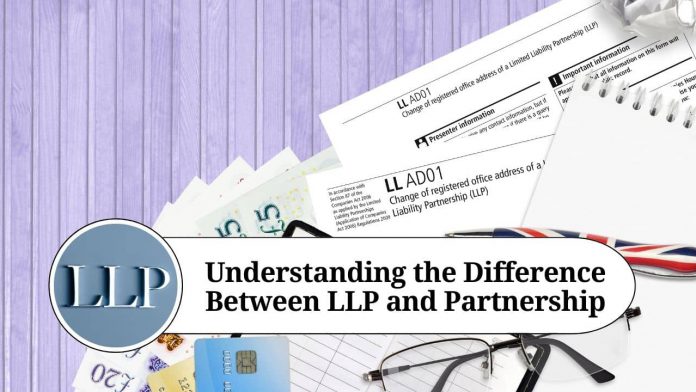When starting a business, one of the important decisions to make is choosing the right legal structure. Two common options are a Limited Liability Partnership (LLP) and a Partnership. While both structures involve two or more people coming together to run a business, there are some key differences between them. In this blog post, we will explore the difference between an LLP and a Partnership.
Definition and Characteristics
A partnership is a business structure in which two or more individuals come together to operate a business. Profits and losses are shared among the partners based on the terms of the partnership agreement.
An LLP, on the other hand, is a hybrid between a partnership and a corporation. In an LLP, the partners have limited liability, meaning they are not personally responsible for the debts and obligations of the business. The profits and losses of an LLP are shared among the partners, but each partner is only liable for the amount of their investment in the business.
Legal Status
A partnership is not a separate legal entity from its owners. This means that the partners are personally liable for the debts and obligations of the business. The partnership itself does not pay taxes; instead, the partners report their share of the profits or losses on their personal tax returns.
An LLP is a separate legal entity from its owners. This means that the LLP can enter into contracts, own property, and sue or be sued in its own name. The LLP pays taxes on its profits, and the partners report their share of the profits or losses on their personal tax returns.
Registration Requirements
In most jurisdictions, partnerships are not required to register with the government. However, partners may need to obtain business licenses and permits depending on the type of business they are operating.
LLPs, on the other hand, are required to register with the government in the jurisdiction where they operate. The registration process typically involves filing articles of incorporation and paying a registration fee.
Management and Control
In a partnership, all partners have an equal say in the management and control of the business. Decisions are made by a unanimous vote, unless the partnership agreement specifies otherwise.
In an LLP, the management and control of the business are typically delegated to a management committee. The partners may or may not have equal say in the management and control of the business, depending on the terms of the LLP agreement.
Liability Protection
One of the most significant differences between a partnership and an LLP is the level of liability protection. In a partnership, each partner is personally liable for the debts and obligations of the business. This means that if the partnership is sued or can’t pay its debts, the partners’ personal assets may be at risk.
In contrast, an LLP offers limited liability protection to its partners. This means that the partners are not personally liable for the debts and obligations of the business beyond their investment in the LLP. This protection can be valuable in industries with high risk or potential for legal action.
Continuity and Transfer of Ownership
In a partnership, the death or departure of a partner can result in the dissolution of the partnership. This means that the remaining partners may need to restructure the business or dissolve it altogether.
In an LLP, the business can continue even if a partner dies or leaves the business. The remaining partners can vote to admit new partners or continue operating as a smaller group. The transfer of ownership in an LLP is also typically easier than in a partnership.
Compliance and Reporting Requirements
Partnerships typically have fewer compliance and reporting requirements than LLPs. However, the specific requirements vary by jurisdiction and industry. Partnerships may need to file annual tax returns, obtain business licenses and permits, and comply with industry regulations.
LLPs are typically subject to more compliance and reporting requirements than partnerships. They may need to file annual reports, maintain certain records, and comply with industry-specific regulations.
Tax Implications
Partnerships and LLPs are both pass-through entities, meaning that the business itself does not pay taxes. Instead, the profits and losses are passed through to the partners, who report them on their personal tax returns.
However, the tax implications can vary depending on the specific structure and ownership of the business. LLPs may be subject to different tax rules and rates than partnerships, and the way that profits and losses are distributed can also affect the tax liability of individual partners.
Cost of Formation and Maintenance
The cost of forming and maintaining a partnership is generally lower than that of an LLP. Partnerships do not typically require formal registration or incorporation, and the legal and accounting fees associated with forming and maintaining a partnership are typically lower than those of an LLP.
Know Other Difference:
- Difference Between E-commerce and E-business
- Difference Between Entrepreneur and Businessman
- Difference Between Entrepreneur and Manager
LLPs, on the other hand, require formal registration and incorporation, which can involve higher legal and accounting fees. In addition, LLPs may be subject to more reporting and compliance requirements, which can also increase the cost of maintaining an LLP.
Conclusion
Choosing the right legal structure for your business is an important decision that can have significant implications for your personal liability, taxes, and management structure. While a partnership and an LLP are similar in many ways, they have some key differences that are worth considering. Ultimately, the choice between a partnership and an LLP will depend on your specific business needs and goals. It is always recommended to seek legal advice before making a decision.
Frequently Asked Questions (FAQ’s)
Q1.) Do LLPs and partnerships offer the same level of liability protection for partners?
No, LLPs offer greater liability protection for partners than partnerships. In an LLP, partners have limited liability for the debts and obligations of the business, while in a partnership, partners have unlimited personal liability.
Q2.) Can a partnership be converted to an LLP?
Yes, a partnership can be converted to an LLP by registering the LLP with the appropriate government agency and following the necessary legal procedures.
Q3.) Can an LLP be converted to a partnership?
Yes, an LLP can be converted to a partnership by winding up the LLP and forming a new partnership with the same partners.
Q4.) Do LLPs and partnerships have different reporting requirements?
Yes, LLPs generally have more reporting requirements than partnerships. For example, LLPs are typically required to file annual reports and maintain a registered office.
Q5.) Are LLPs and partnerships subject to the same tax rules?
LLPs and partnerships are both pass-through entities, which means that the business itself does not pay taxes. Instead, the profits and losses are passed through to the partners, who report them on their personal tax returns. However, there may be differences in the way LLPs and partnerships are treated for tax purposes depending on the jurisdiction and the specific circumstances of the business.
Q6.) How are partnerships and LLPs taxed?
Partnerships and LLPs are both pass-through entities, which means that the business itself does not pay taxes.
Q7.) How many partners can a partnership have?
A partnership can have any number of partners, although many partnerships are small businesses with just two or three partners.
Q8.) How many partners can an LLP have?
An LLP can have an unlimited number of partners, which allows for more flexibility in terms of ownership and management.
Q9.) How do I choose between a partnership and an LLP?
The choice between a partnership and an LLP depends on a number of factors, including liability protection, management structure, compliance requirements, tax implications, size of the business, and cost. Seeking the advice of a legal or financial professional can help you make an informed decision that best meets the needs of your business.
Q10.) Can an LLP have both active and silent partners?
Yes, an LLP can have both active and silent partners. Active partners are involved in the day-to-day operations of the business, while silent partners contribute capital but do not participate in management or decision-making. The roles and responsibilities of each partner should be defined in the LLP agreement.




















